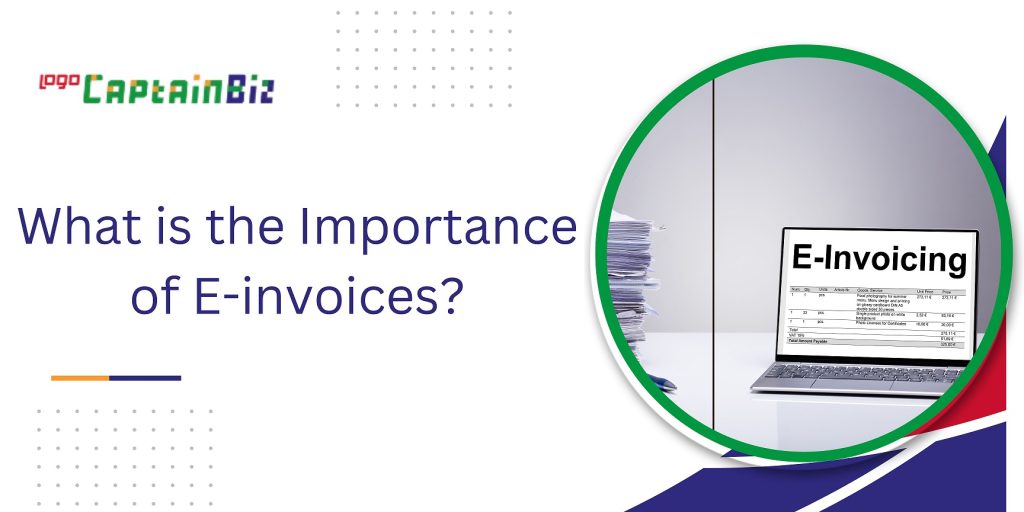E-invoice implementation is no longer just a theoretical idea but a genuine possibility of changing how companies run and engage with their financial procedures. Organizations in various industries utilize electronic invoicing in this age of digital transformation to streamline processes, cut expenses, and improve overall competitiveness.
We go into real-world examples and success stories in this article, highlighting the influence of E-invoicing and demonstrating how it can spur productivity, accuracy, and creativity in various industries. These cases prove the significant change that implementing E-invoices may bring to the corporate environment.
Understanding the Concept of E-invoicing
Bills must be sent to suppliers and customers for any firm to have a positive cash flow. Nevertheless, the conventional paper method is frequently laborious and prone to errors. Therefore, with the digital advancement came E-invoices, or electronic invoices.
E-invoice implementation has become relatively straightforward. Companies can opt for specialized software, such as the one available with Captainbiz, that can assist them in automating every stage of invoicing. This software can help generate invoices and even distribute them to your recipients.
There are numerous E-invoice use cases these days and in every type of industry. Because of E-invoicing, businesses can speed up their billing process, reduce errors, and follow the invoice process and rules outside their country.
Why did the GST Council introduce E-invoices?
The GST Council introduced E-invoices in its 37th meeting in Sep 2019. The GST council realized there was a need as, despite some fantastic invoicing software available, no two machines could read and comprehend an invoice. Therefore, the GST council introduced the concept of E-invoices, where all the electronic data related to invoices are stored in a standardized format that is easy to read and interpret.
These days, there are so many different invoicing software, such as the one that is available with Captainbiz to help in preparing E-invoices. You can use the GST software with Captainbiz, which is standardized according to the GST norms. You will design and share accurate E-invoices with your clients and vendors.
What is the Importance of E-invoices?

As a business, you can gain numerous advantages by E-invoice implementation. Some companies are still using the paper method of producing invoices. Below is one of the most crucial benefits of shifting to a reputed software, such as Captainbiz, for all your E-invoices:
Cost-Effective
Businesses can incur significant costs associated with paper documents when they utilize paper invoicing. In a survey of 1485 businesses, CFO magazine discovered that the bottom 25% were spending more than $10 on paper invoices. It is a considerable number when raising invoices to get your money.
Therefore, using E-invoices can help companies cut down on paper expenses. This is because when companies prefer E-invoices, they do not have to worry about printing and couriering them to the recipients. It will also save time and employee efforts that can be used toward more critical tasks.
E-invoicing in India
E-invoice implementation has become quite popular with indirect taxation in recent years. E-invoicing influences tax compliance, the difficulties businesses experience in fulfilling real-time or nearly real-time reporting obligations, and the digital tax transformation it requires are the main reasons for the enthusiasm surrounding E-invoicing.
E-invoicing has long been the standard in many countries throughout the world. To speed up and streamline the invoicing process, the Indian government implemented the E-invoicing system. Electronic invoices linked to the Goods and Service Tax Network (GSTN) validate business-to-business (B2B) transactions in India.
The Invoice Registration Portal (IRP) assigns an Invoice Reference Number (IRN) to each invoice transaction. “E-invoicing,” a standard format for creating invoices, facilitates communication and collaboration with various systems and individuals involved in invoicing.
Case Studies of E-invoice Implementation in Different Industries
Its success rate is the one thing people want to know before putting it into practice. The same holds for electronic invoices. E-invoices are being used in numerous companies across industries. Here are some of the remarkable E-invoice success stories for your understanding:
ArcelorMittal
ArcelorMittal is a leading steel and mining company that decided to eliminate its manual invoicing process and go for E-invoicing. They are pioneers in producing safe and sustainable steel and have clients in numerous sectors, such as construction, automobile, packaging, and household appliances. They are in 60 countries and industries in more than 18 nations. With such a huge business, they estimated sending close to 2 million invoices each year.
Thus, they needed a cost-effective solution that followed all the processes across different nations. As ArcelorMittal moved its clients to electronic invoicing, the system also had to handle a large volume of invoices and be able to transmit them in a variety of formats. Therefore, they used an E-invoice software platform like Captainbiz to help them with their intense E-invoice process.
Morgan Sindall
Morgan Sindall is a renowned organization in the UK delivering construction and regeneration projects. They have also been using the E-invoice software for decades, which has helped them strengthen their supply chain relationship with their vendors and customers. Now, they do not have to wait to receive any invoice and can share E-invoices instantly.
How to Achieve Success with E-invoice Implementation?
Here are the steps you should follow if you want to do E-invoice implementation in your company.
Understand the Legislative Requirements
Every country has a different E-invoice requirement that the companies must follow. Consequently, finding out what those legal requirements are is the first step. You must also ensure that you execute all of your tasks accurately and per the guidelines established by the appropriate authorities. The following are the primary explanations for acting in this manner:
- It would help if you got approval from your tax authority to meet the technical requirements of the E-invoices issuance, exchange, receipt, and acceptance process.
- To issue an E-invoice that is in a universally accepted format.
- To make sure that there is the right content as agreed by the authorities.
- To archive the records as per your country’s requirements.
- To follow the data security protocols.
Understanding the Method of Rolling Out E-invoice
There are many approaches to implementing E-invoices; your company’s needs should determine your choice and how you go about it. Here are some examples of standard methods:
- E-invoices using cloud archives
- E-invoices and on-premise archives
- Incoming document archiving and automation of data entry via XML
- Automated data input for orders that are sent out and incoming business papers
Check If Your Partners are Using E-invoicing
E-invoicing implementation helps in getting paid sooner and quicker. Hence, you must check if your partners are using this system. If they, too, utilize the electronic invoice system, it will be easier for you to send them invoices and vice versa. You can still motivate them to start by explaining the benefits of the practice if they aren’t already.
Look for a Reliable Provider
Choosing the right and reliable invoicing partner is the most essential step. Here, Captainbiz can be of help as they can help you meet your business’s specific requirements. They are the best in business and can offer compatibility with local invoice regulations. Additionally, they provide customized solutions to all businesses.
Moreover, CaptainBiz has plans that can be well aligned with your budget. They have options from a 3-month plan to over a year, and you can choose based on your needs and budget. Most importantly, they are known for their customer service qualities and years of knowledge and experience.
Train Your People
Lastly, for any process to be successful, the teams need to understand and implement them correctly. Therefore, it is a necessity that your IT and accounting teams go through thorough training on how the E-invoice software works and functions. Through this training, they will be able to leverage the most out of the system.
Conclusion
Implementing E-invoices is becoming more than a trend in the rapidly changing finance and business industries. It is a strategic necessity. The actual use cases and success stories examined throughout this article demonstrate the fantastic potential of electronic invoicing to revolutionize industries, improve efficiency, and stimulate creativity.
The promise of increased productivity, decreased errors, and improved competitiveness through electronic invoices will influence business transactions in the future and guarantee a more interconnected, effective, and sustainable global economy as long as enterprises continue to embrace this digital transformation.
FAQs
-
Why do businesses need E-invoices?
Businesses must provide invoices to clients so they can see what goods or services they have purchased from them. These invoices include a breakdown of the buyer’s price for the goods and services.
-
What is the use of E-invoice?
Thanks to automation and rigorous inspections, E-invoicing significantly reduces the number of fraudulent GST invoices and guarantees that input tax credit is claimed on legitimate GST invoices. It is simple for GSTN to find someone attempting to claim a deceitful tax credit with the E-invoice implementation.
-
What is the latest notification for E-invoice 2023?
The Central Board of Indirect Taxes (CBIC) released Notification No. 10/2023 – Central Tax, dated May 10, 2023. This notification lowers the E-invoicing turnover limit to Rs 5 Crore, which will take effect on August 1, 2023.
-
How can users implement E-invoices as a first-time user?
For E-invoice implementation, users must log in to the E-invoice portal. They will have to register themselves and click on E-invoice enablement. Afterward, they must enter GSTIN and the annual turnover with the financial year and submit.
-
What are the uses of E-invoices?
E-invoices can help businesses with maintaining records, payment tracking, legal protection, easy tax filing, and doing business analysis.
-
Which companies are exempted from using E-invoices?
Some categories are exempted from using E-invoices. They are insurance companies, financial institutions or banking companies, non-banking financial companies, and goods transport agencies.
-
What will happen if a company fails to generate E-invoices?
Any organization failing to generate E-invoices can be issued heavy penalties from the government’s end. The penalty equals Rs. 10,000 or 100% of the tax due on the supply, whichever is higher.
-
What is the time limit to E-invoice?
For all tax invoices and credit-debit notes issued, the deadline for generating an electronic invoice on the Invoice Registration Portal (IRP) is thirty days from the date specified on the invoice, debit note, or credit note.
-
Who all are liable for E-invoices?
Businesses having an annual turnover over Rs. 10 crores are mandated by the GSTN’s most recent rules to produce electronic invoices for business-to-business transactions. Every business transaction requires an E-invoice, which must be generated by the registered company using the E-invoicing system.
-
Can an E-invoice be canceled?
Businesses can cancel an E-invoice within 24 hours of generating the same.

